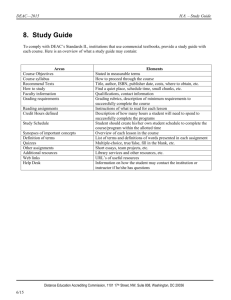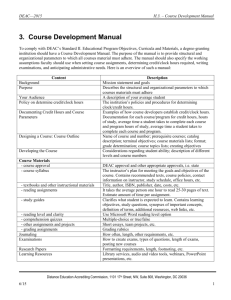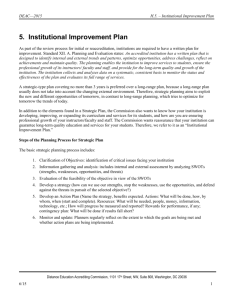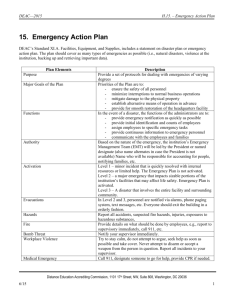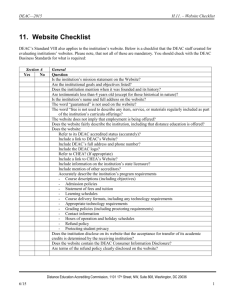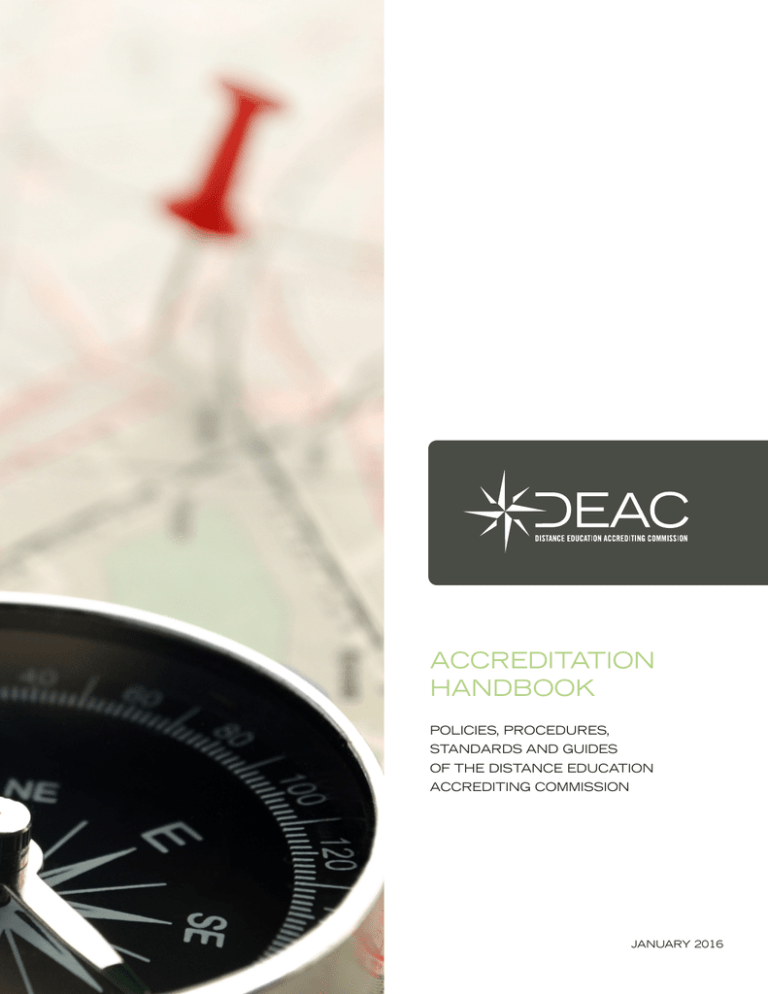
ACCREDITATION
HANDBOOK
POLICIES, PROCEDURES,
STANDARDS AND GUIDES
OF THE DISTANCE EDUCATION
ACCREDITING COMMISSION
JANUARY 2016
DEAC Accreditation Handbook
Copyright ©2016 by the Distance Education Accrediting Commission.
All rights reserved.
Published by the:
Distance Education Accrediting Commission
1101 17th Street, NW, Suite 808
Washington, D.C. 20036
202-234-5100; fax: 202-332-1386
Website: www.deac.org
Accredited institutions must be in full compliance by July 1, 2016 with any revisions or
additions to the 2016 DEAC Accreditation Handbook.
First Edition: January 1990
23rd Edition: January 2016
The Distance Education Accrediting Commission is listed by the United States Department of
Education as a recognized institutional accrediting agency for distance education. The DEAC is
also recognized by the Council for Higher Education Accreditation (CHEA). The U.S.
Department of Education and CHEA recognition is for postsecondary educational institutions
only.
TABLE OF CONTENTS
PART ONE: INTRODUCTION................................................................................................................................. 4
ABOUT DEAC............................................................................................................................................................ 4
PURPOSE OF THE ACCREDITATION HANDBOOK .......................................................................................................... 4
WHAT IS DISTANCE EDUCATION? .............................................................................................................................. 5
WHY BECOME ACCREDITED ?..................................................................................................................................... 6
WHAT IS DEAC ACCREDITATION AND WHAT ARE ITS BENEFITS? ............................................................................ 6
FOR STUDENTS, DEAC ACCREDITATION… ............................................................................................................... 7
FOR INSTITUTIONS, DEAC ACCREDITATION… .......................................................................................................... 7
FOR THE PUBLIC, DEAC ACCREDITATION… ............................................................................................................. 8
FOR GOVERNMENT AND INDUSTRY PROFESSIONALS, DEAC ACCREDITATION… ...................................................... 8
DEAC TODAY ............................................................................................................................................................ 8
RECOGNITION BY THE UNITED STATES DEPARTMENT OF EDUCATION ....................................................................... 8
RECOGNITION BY THE COUNCIL FOR HIGHER EDUCATION ACCREDITATION (CHEA) ............................................... 9
PART TWO: PROCESSES AND PROCEDURES ............................................................................................. 10
INTRODUCTION ........................................................................................................................................................ 10
I. E LIGIBILITY REQUIREMENTS ................................................................................................................................. 10
II. APPLICATION, SELF-E VALUATION REPORT, AND READINESS ASSESSMENT ........................................................ 12
III. CURRICULAR REVIEW ........................................................................................................................................ 13
IV. CONSIDERATION OF THIRD PARTY INFORMATION .............................................................................................. 17
V. ON-SITE EVALUATION ......................................................................................................................................... 18
VI. THE C HAIR’S REPORT, RESPONSE, AND THE COMMISSION’S DECISION .............................................................. 19
VII. COMMISSION ACTIONS ON INITIAL AND RENEWAL OF ACCREDITATION ........................................................... 19
VIII. APPEALING THE COMMISSION’S ADVERSE DECISION ...................................................................................... 23
IX. B INDING ARBITRATION ...................................................................................................................................... 26
X. NOTIFICATION AND INFORMATION SHARING ....................................................................................................... 27
XI. INSTITUTIONAL NOTIFICATIONS ......................................................................................................................... 31
XII. PETITIONS AND WAIVERS ................................................................................................................................. 31
XIII. SUBSTANTIVE CHANGES .................................................................................................................................. 32
XIV. NON-S UBSTANTIVE CHANGES ......................................................................................................................... 51
XV. TEACH-OUT P LANS .......................................................................................................................................... 54
XVI. ANNUAL REPORTS ........................................................................................................................................... 57
XVII. COMPLAINTS (ACCREDITED INSTITUTIONS, ACTIVE APPLICANTS, AND DEAC) ............................................ 60
XVIII. UNETHICAL BEHAVIOR ................................................................................................................................. 64
XIX. REVIEWING, ADOPTING, AND CIRCULATING CHANGES TO THE ACCREDITATION HANDBOOK ........................ 64
PART THREE: ACCREDITATION STANDARDS ............................................................................................. 69
I. INSTITUTIONAL M ISSION ....................................................................................................................................... 69
II. INSTITUTIONAL E FFECTIVENESS AND STRATEGIC P LANNING .............................................................................. 69
III. PROGRAM O UTCOMES, CURRICULA, AND MATERIALS ....................................................................................... 70
IV. EDUCATIONAL AND STUDENT SUPPORT SERVICES ............................................................................................. 77
V. STUDENT ACHIEVEMENT AND SATISFACTION ..................................................................................................... 79
VI. ACADEMIC LEADERSHIP AND FACULTY Q UALIFICATION ................................................................................... 80
VII. ADVERTISING, PROMOTIONAL LITERATURE, AND RECRUITMENT PERSONNEL ................................................. 83
VIII. ADMISSION PRACTICES AND ENROLLMENT AGREEMENTS .............................................................................. 86
IX. F INANCIAL DISCLOSURES, CANCELLATIONS, AND REFUND POLICIES ................................................................ 90
X. INSTITUTIONAL GOVERNANCE ............................................................................................................................ 95
XI. F INANCIAL RESPONSIBILITY .............................................................................................................................. 96
Distance Education Accrediting Commission, 1101 17 th Street NW, Suite 808, Washington, DC 20036
Page 2
XII. FACILITIES, EQUIPMENT, SUPPLIES, RECORD PROTECTION AND RETENTION .................................................... 97
PART FOUR: APPENDICES............................................................................................................................... 100
I. CONFLICT OF INTEREST ....................................................................................................................................... 100
II. CONFLICT OF INTEREST DISCLOSURE FORM ...................................................................................................... 104
III. CODE OF CONDUCT FOR ON-S ITE EVALUATORS .............................................................................................. 106
IV. SELECTING AND TRAINING COMMISSIONERS ................................................................................................... 108
V. SELECTING AND TRAINING EVALUATORS .......................................................................................................... 112
VI. SELECTING AND TRAINING APPEALS PANEL MEMBERS ................................................................................... 117
VII. OBLIGATIONS OF ACCREDITATION .................................................................................................................. 120
VIII. DEAC CODE OF ETHICS FOR STUDENT RECRUITMENT PERSONNEL .............................................................. 122
IX. ENGLISH LANGUAGE PROFICIENCY ASSESSMENT ............................................................................................ 124
X. STUDENT ACHIEVEMENT BENCHMARKS ............................................................................................................ 126
XI. STUDENT ACHIEVEMENT AND SATISFACTION .................................................................................................. 127
XII. P ILOT PROGRAMS ........................................................................................................................................... 131
XIII. GLOSSARY ..................................................................................................................................................... 133
XIV. DETC BYLAWS ............................................................................................................................................. 147
Distance Education Accrediting Commission, 1101 17 th Street NW, Suite 808, Washington, DC 20036
Page 3
PART ONE: INTRODUCTION
ABOUT DEAC
Accreditation in education began over a century ago. The movement started as a public reaction
to the extreme differences between educational institutions that initially appeared to be similar.
Accrediting bodies were voluntarily organized by educators to develop and implement common
standards and procedures to measure educational quality. From its inception, accreditation has
been a nongovernmental, completely voluntary, peer group method of identifying educational
institutions or programs that meet published standards of quality. A variety of regional, national,
and professional accrediting organizations came into being in the early 1900s in response to the
public’s demand for reliable indicators of institutional quality. The Distance Education
Accrediting Commission (DEAC) was founded in 1926 as an association under the name
“National Home Study Council” to promote education quality and ethical business practices for
correspondence education programs. In 1955, the Accrediting Commission was established. It
created and implemented accreditation standards and procedures to examine and approve
distance learning institutions. In 1959, the Accrediting Commission received its first grant of
federal recognition and was listed by the U.S. Commissioner (now Secretary) of Education as a
recognized accreditor. In 1994, the name of the organization changed from the National Home
Study Council to the Distance Education and Training Council, and in 2015, was changed to the
Distance Education Accrediting Commission. The DEAC applies its standards and policies in a
manner that respects the mission of an institution, including those with faith-based or religious
missions, to ensure and advance the aim of institutional improvement and effectiveness. The
vision and mission of the DEAC is as follows:
VISION
The Distance Education Accrediting Commission is the preeminent accrediting
organization for distance education delivered worldwide that sets high standards for
academic quality, inspiring excellence in teaching, learning, and student outcomes
through voluntary assessment and peer review.
MISSION
Assuring students high quality distance education through accreditation, peer review, and
institutional improvement.
PURPOSE OF THE ACCREDITATION HANDBOOK
DEAC has prepared this Accreditation Handbook as a compilation of its processes, procedures,
and standards. It is intended to assist institutions in understanding and preparing for evaluation
by DEAC. Institutions should use it as they organize and conduct their self-evaluations, as they
evaluate their readiness to meet the rigors inherent in voluntary accreditation, and as they work
to maintain the standards of DEAC. Finally, this Accreditation Handbook offers guidance to
newly established distance education institutions seeking to build or refine their policies and
practices, whether or not they apply for DEAC accreditation. Evaluator’s Rating Forms, Guide to
Self-Evaluation, Applications, and Report Forms are found on DEAC’s website at
www.deac.org. Please note: Institutions should always check the website for the most up-to-date
versions of these documents.
Distance Education Accrediting Commission, 1101 17 th Street NW, Suite 808, Washington, DC 20036
Page 4
WHAT IS DISTANCE EDUCATION?
Distance education, also known as online education, correspondence education, or Internet-based
learning, is designed for learners who live at a distance from residential educational providers
and/or institutions. Distance education has evolved in recent years to also include an increasing
number of adult learners who may be within reasonable proximity to a residential campus, but
because of work and personal responsibilities are unable to regularly attend a physical campus.
Additionally, these adult learners consider themselves to be self-starters and more independent
students who thrive in an environment that provides a balance between flexibility and structure.
Distance education has a rich history dating back to the early 18 th century when its predominant
medium of instruction was printed materials that were mailed to individual students and allowed
for little to no interaction with faculty members. Distance education today has taken advantage
of technological innovations and has become a multi-faceted avenue for providing instruction
through various mediums to meet the learning needs of a diverse, growing student population.
Educational institutions can reach across borders and extend globally to build strong learner
communities through the use of technological tools such as social media outlets, podcasts,
various forms of asynchronous and synchronous communication, and videoconferencing.
Advancements within the field of distance education have provided an increasing population of
students the opportunity to earn degrees and gain knowledge and skills in various subject areas.
For institutions participating in Federal Student Assistance programs, the U.S. Department of
Education defines distance education as “education that uses one or more of the technologies
listed in paragraphs (1) through (4) to deliver instruction to students who are separated from the
instructor and to support regular and substantive interaction between the students and the
instructor, either synchronously or asynchronously (see CFR 34, § 602.3). The technologies may
include:
1) The Internet;
2) One-way and two-way transmissions through open broadcast, closed circuit, cable,
microwave, broadband lines, fiber optics, satellite, or wireless communication devices;
3) Audio-conferencing; or
4) Video cassettes, DVDs, and CD-ROMs, if the cassettes, DVDs, or CD-ROMs are used in
a course in conjunction with any of the technologies listed in paragraphs (1) through (3).”
Based on this definition by the U.S. Department of Education, institutions that deliver instruction
through correspondence education are not eligible to participate in federal student aid.
Correspondence education, as defined by the U.S. Department of Education, “means:
1) Education provided through one or more courses by an institution under which the
institution provides instructional materials, by mail or electronic transmission, including
examinations on the materials, to students who are separated from the instructor;
2) Interaction between the instructor and the student is limited, is not regular and
substantive, and is primarily initiated by the student;
3) Correspondence courses are typically self-paced; and
4) Correspondence education is not distance education.”
Distance Education Accrediting Commission, 1101 17 th Street NW, Suite 808, Washington, DC 20036
Page 5
DEAC limits eligibility to participate in Federal Student Assistance programs to institutions that
demonstrate substantive interaction between the students and instructor/faculty. DEAC’s scope
of accreditation extends to both distance education and correspondence education institutions.
For the purposes of the DEAC Accreditation Handbook, the term “distance education” is used
throughout, whether the instructional model is correspondence, online, or direct assessment.
WHY BECOME ACCREDITED?
Accreditation communicates quality to students, institutions, the public, government, and other
industry professionals. Accreditation provides assurances that a program has met established
standards necessary to produce graduates who have achieved stated learning outcomes and are
ready to enter the global marketplace. Students who graduate from accredited institutions have
greater opportunities for employment, continued education, and mobility.
Generally, accreditation in other countries is controlled by the government and is often required.
By contrast, accreditation in the United States is a voluntary, peer-review process and is carried
out by nongovernmental, nonprofit organizations. The peer-review process allows institutions to
be evaluated by other education professionals working in the industry who understand the needs
and demands from a shared perspective. Additionally, the peer-review process provides checks
and balances from within the industry to allow institutions to have an opportunity to meet
students’ educational goals by using a variety of resources while ensuring quality programs.
WHAT IS DEAC ACCREDITATION AND WHAT ARE ITS BENEFITS?
Distance education is not a new idea or concept but has been around since the early 18th century
in Europe and early 19th century in the United States, predominantly through print-based
correspondence programs. These pioneering students who took advantage of distance education
were mostly individuals living in rural or remote areas who did not have access to residential
educational institutions. Another growing population of students came from members of the
military. A number of correspondence education institutions saw a significant increase after
World War II as returning service members continued to pursue their educational goals.
With the increasing focus on distance education, it was important that the public have confidence
in the quality of education provided by institutions. Given the unique nature of distance
education delivery, accreditation expectations for residential education programs were not
always appropriate to effectively evaluate education quality for distance education; therefore,
accrediting organizations, such as the Distance Education Accrediting Commission, were formed
to offer an accreditation oversight process specifically to meet the unique quality assurance
needs of distance education institutions.
Today, institutions offering distance education curricula use a variety of innovative technologies.
Despite the various advantages provided by distance education, students and the public need
assurances that the credential earned has value and that students have access to all related
services necessary to support their success. DEAC accreditation standards establish education
quality expectations and assess an institution’s ability to integrate technology to meet the needs
of 21st century graduates and employers. DEAC standards are designed to accommodate the need
for institutions to explore learning resources and student support services beyond those of
traditional campus-based institutions. Additionally, DEAC accreditation recognizes that, by
Distance Education Accrediting Commission, 1101 17 th Street NW, Suite 808, Washington, DC 20036
Page 6
meeting the unique needs of the distance learning student, course and program delivery can
expand an institution’s reach beyond a regional focus to a national and international presence.
When accredited distance education institutions are successful, students can benefit, regardless
of geographic location, and can organize their studies to fit within personal life commitments.
DEAC-accredited institutions encompass a broad variety of educational offerings through
distance education. DEAC institutions may be organized as for-profit degree-granting or nondegree-granting, nonprofit degree- and non-degree-granting, faith-based institutions, and as
training and educational providers that offer students more choices to meet their educational
goals. Students can choose the institutions that best meet their needs while being provided
assurances that the chosen program, when appropriately accredited, is commensurate in quality
to other traditional programs offered in their home state or country.
DEAC accreditation provides quality assurance to students (prospective, current, and graduates),
institutions, the public, government, and industry professionals.
FOR STUDENTS, DEAC ACCREDITATION…
Provides students with confidence that the institution offering programs, ranging from
high school through the professional doctoral degree and non-degree certificates, have
been evaluated and meet rigorous standards established by education industry
professionals.
Increases and enhances employment opportunities for students who graduate from an
accredited institution. Graduates want assurances that, upon completion of the program,
they have the requisite knowledge and skills to meet their educational goals.
Verifies that the unique methods for delivering curricula are consistent with educational
best practices and provides students with assurances that the education they are paying
for is valuable and worth their time, money, and effort.
Allows institutions to prepare students by supporting their achievement of knowledge,
skills, and abilities to be productive individuals who contribute to their community and
continue lifelong learning.
FOR INSTITUTIONS, DEAC ACCREDITATION…
Allows an institution to receive public recognition for the quality programs and services
offered to students.
Promotes the integration and continuous improvement of “best practices” in support of
student achievement and institutional growth.
Documents that an institution is true to its mission, goals, and objectives by measuring
the achievement of each for purposes of continuous self-assessment.
Allows institutions to be eligible for and apply for various professional and programmatic
accreditations.
Allows institutions the option of participating in Federal Student Assistance and military
programs to benefit students in need of financial assistance to realize their educational
goals.
Allows institutions to apply for approval in some states that only allow accredited
institutions.
Distance Education Accrediting Commission, 1101 17 th Street NW, Suite 808, Washington, DC 20036
Page 7
FOR THE PUBLIC, DEAC ACCREDITATION…
Provides a consistent and reliable indicator that institutions meet standards of quality and
provides validation of credibility through a structured peer review process.
Promotes accountability to other member institutions and various stakeholders.
Supports and encourages the innovation and use of technology by emphasizing
continuous improvement processes to assure that institutions and graduates can compete
in a global economy.
FOR GOVERNMENT AND INDUSTRY PROFESSIONALS, DEAC ACCREDITATION…
Provides an opportunity for industry professionals to offer input and observations that
reflect current and future employment needs in a changing global economy.
Demonstrates to various federal and state regulators that accredited institutions are
leaders in the field of distance education and strive to prepare a workforce equipped to
contribute to the changing economic landscape.
Provides the opportunity for member institutions to lead the change necessary in the field
of education by offering students the chance to increase their knowledge and skills while
meeting their personal and professional responsibilities.
DEAC TODAY
The DEAC is recognized by the U.S. Secretary of Education and by the Council for Higher
Education Accreditation (CHEA) as an institutional accrediting organization for postsecondary
distance education institutions that offer programs primarily by the distance education method at
the levels of non-degree, high school, postsecondary, and higher education, including the
professional doctoral degree.
DEAC’s goals are to assure a high standard of educational quality in the distance education
institutions it accredits by requiring compliance with its published standards and procedures and
by fostering continual self-improvement. DEAC is dedicated to ensuring a quality education for
more than two million students who annually study at its accredited institutions.
RECOGNITION BY THE UNITED STATES DEPARTMENT OF EDUCATION
DEAC initially received federal recognition in 1959 and has continually held recognition by the
United States Department of Education ever since. Federal recognition aims to ensure that
accreditors meet expectations for institutional and program participation in federal activities,
such as federal financial aid programs. Currently, the federal recognition process is largely
carried out by the National Advisory Committee for Institutional Quality and Integrity
(NACIQI). The NACIQI provides recommendations to the United States Secretary of Education
concerning whether accreditation standards are sufficiently rigorous and effective toward
ensuring that a recognized accreditor is a reliable authority regarding the quality of the education
provided by the institutions it accredits. In 2012, NACIQI recommended to the Secretary of
Education that DEAC receive recognition through 2017. DEAC’s scope of recognition by the
Secretary of Education is:
The accreditation of postsecondary institutions in the United States that offer degree and/or nondegree programs primarily by the distance or correspondence education method up to and
including the professional doctoral degree, including those institutions that are specifically
Distance Education Accrediting Commission, 1101 17 th Street NW, Suite 808, Washington, DC 20036
Page 8
certified by the agency as accredited for Federal Student Assistance program purposes.
RECOGNITION BY THE COUNCIL FOR HIGHER EDUCATION ACCREDITATION (CHEA)
CHEA was formed in 1996 by presidents of United States colleges and universities to
demonstrate higher education quality through strengthened accreditation processes. It promotes
academic quality through formal recognition of higher education accrediting bodies and works to
advance self-regulation in higher education through accreditation. Recognition by CHEA affirms
that the standards and procedures of accrediting organizations meet the academic quality,
institutional improvement, and accountability expectations CHEA has established. DEAC first
received recognition by CHEA in 2001. It received its most recent grant of recognition from
CHEA in 2013. DEAC’s scope of recognition by CHEA is:
The accreditation of higher learning institutions in the United States and international locations
that offer programs of study that are delivered primarily by distance (51 percent or more) and
award credentials at the associate, baccalaureate, master’s, first professional and professional
doctoral degree level.
Distance Education Accrediting Commission, 1101 17 th Street NW, Suite 808, Washington, DC 20036
Page 9

